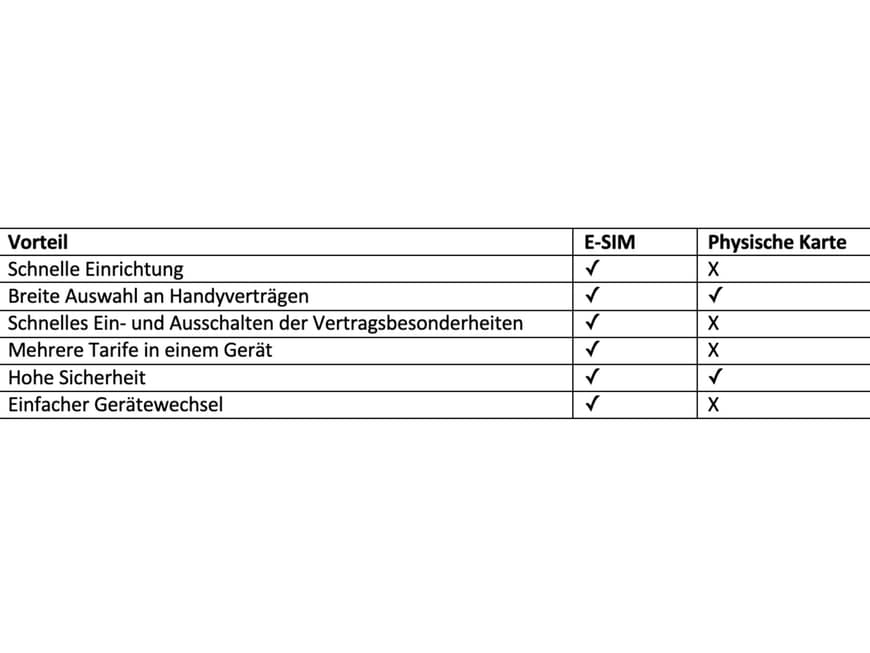
The pitfalls of a physical SIM card
The small plastic SIM card in various sizes was the standard in smartphones and other mobile devices for many years. The physical card still dominates the mobile phone sector in Germany today, but as many as seven million people have already switched to e-SIM technology. The physical SIM card quickly causes a few inconveniences:
- Installing and removing the card is comparatively complicated. This requires a special small aluminum tool or a needle, which triggers the opening mechanism of the compartment into which the card is inserted.
- It is particularly common for the small plastic card to get lost in the hustle and bustle of everyday life. Once it has disappeared, it is difficult to find again and will probably have to be replaced with a costly replacement.
- If the contacts on the card are damaged, it may no longer be possible to read it and a new SIM card will also have to be requested from the telecommunications provider.
- If you do not want to use the SIM card abroad, it may have to be removed from the smartphone to avoid roaming charges outside the EU. Electronic SIM cards, on the other hand, can be easily deactivated in the settings.
- Using the card on a new smartphone involves the effort of removing it and inserting it into the new device. With an electronic SIM card, the switch is completely digital.
Overall, physical SIM cards offer less flexibility compared to the modern E-SIM alternative and present users with problems or annoying additional work more quickly. If the smartphone used has an E-SIM function, it is therefore worth using it.
Tip: Almost every cell phone contract provider now offers the option of switching from a physical SIM card to an E-SIM without high additional costs.
What does E-SIM mean?
Basically, "SIM" stands for "subscriber identity module", which roughly translates as subscriber identity module. This is a uniquely assignable chip that is authorized for a specific phone number and user. The "E" in E-SIM means "embedded". This means that the SIM card is stored directly on a chip in the respective smartphone, which can be loaded with individual information. This means that an external card is no longer necessary.
Data transmission with the E-SIM works via encrypted signals that are sent between the mobile network and the device. As the digital card is permanently installed in the device, there is no need for physical replacement and set-up, which makes initial commissioning easier and offers particular advantages when traveling.
Flexibility and convenience: the advantages of the E-SIM
If you opt for a cell phone contract with or without a cell phone, you should make sure that the device you choose is E-SIM-capable. Once the contract has been concluded, the E-SIM can be set up digitally immediately and does not need to be sent. Within a few hours, users can make full use of the mobile network.
Ideal for travelers
Those who use an E-SIM are more flexible and can switch between contracts more quickly. Most devices can easily store up to three different E-SIM cards, which can be switched on or off as required. For example, it is possible to create cards for different countries or to use a private and business telephone number in parallel.
Tip: If users are traveling in a foreign country, a local E-SIM can easily be purchased online or from a specialist store. Thanks to the simple setup, it only takes a few minutes before the mobile network can be used while traveling. The electronic card also eliminates the hassle of entering a SIM PIN.
Convenience and ease of use
The E-SIM can be activated quickly and easily using a QR code or a corresponding code and is immediately ready for use. The setup is simple and is usually explained clearly by the provider of the cell phone contract. When changing devices, the existing E-SIM can be easily transferred to a new device and there are no costs for sending a new card by post.
Last but not least , cell phone contract offers for E-SIM contracts are often somewhat cheaper, as there is less work for the provider of the cell phone contract and, for example, no documents have to be sent by post. Today, the vast majority of all contracts are therefore E-SIM-capable.

Are there any security gaps with the E-SIM?
The transmission of the profile takes place within an encrypted connection that nobody can intercept. According to experts, this is no less secure than when using a physical SIM card. If a smartphone with an E-SIM is stolen, the process is therefore the same as with a physical card - the card should be blocked as quickly as possible via the mobile phone provider.
Final tip: There is no longer a SIM PIN for the E-SIM. It is therefore advisable to protect your smartphone against unauthorized access with a code of at least six digits or your own fingerprint or face. This way, security is never compromised, even with a new digital card.
